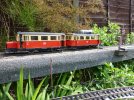I picked up an LGB Wismar 'pigsnout' railcar last month, with the intention of making it look more like a small County Donegal-ish item. I'm sure someone has done this, but can I find the article/build log? No, of course not.
So the first thing to do is flip it upside-down and remove one of the bonnets; it made sense to leave the one at the driver's end. This then gave front and rear ends. The rear end was removed, and the sliding doors removed, along with handles, grab rails and windows. The sliding doors were cut down in width by 1mm, had the sliding parts removed and all surface detail cut away with a sharp knife before flatting down.
View attachment 336331
View attachment 336332
The floor is lower in the driver's cab area, so a false floor was made from 8mm strip wood and 1mm plasticard.
View attachment 336333
View attachment 336334
Although not very clear in the picture, all moulded detail of the driver's controls and jump seats have been removed from the front wall of the cab at this end, too. Then the rear steps were removed, as they will serve no purpose without any rear doors!
View attachment 336335
The rear centre buffer mount was also cut off, and all the printed detail on the sides was sanded off.
View attachment 336336
The doors were trimmed to height and then the uprights were cut away from one side of the door and the railbus body. Ideally, I would make the rear windscreen surround vertical, but doing so would generate a huge amount of work for a minor visual benefit, so I'm leaving it. For now, at least.
A quick dry assembly with clamps shows progress so far.
View attachment 336337














